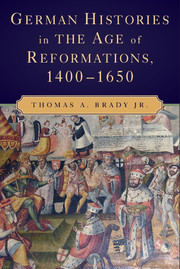Book contents
- Frontmatter
- Contents
- Figures, Maps, and Tables
- Acknowledgments
- A Note on Usages
- Map 1 The Empire in 1547
- Map 2 The Peace of Westphalia, 1648
- Part I The Empire, the German Lands, and Their Peoples
- Part II Reform of the Empire and the Church, 1400–1520
- 5 Reform of Empire and Church
- 6 The Empire and the Territorial States
- 7 The Reform of the Empire in the Age of Maximilian I
- 8 Ideals and Illusions of Reforming the Church
- Part III Church, Reformations, and Empire, 1520–1576
- Part IV Confessions, Empire, and War, 1576–1650
- Appendix
- Glossary
- Bibliography
- Index
8 - Ideals and Illusions of Reforming the Church
Published online by Cambridge University Press: 05 June 2012
- Frontmatter
- Contents
- Figures, Maps, and Tables
- Acknowledgments
- A Note on Usages
- Map 1 The Empire in 1547
- Map 2 The Peace of Westphalia, 1648
- Part I The Empire, the German Lands, and Their Peoples
- Part II Reform of the Empire and the Church, 1400–1520
- 5 Reform of Empire and Church
- 6 The Empire and the Territorial States
- 7 The Reform of the Empire in the Age of Maximilian I
- 8 Ideals and Illusions of Reforming the Church
- Part III Church, Reformations, and Empire, 1520–1576
- Part IV Confessions, Empire, and War, 1576–1650
- Appendix
- Glossary
- Bibliography
- Index
Summary
I never saw, heard, nor read, that the clergy were beloved in any nation where Christianity was the religion of the country. Nothing can render them popular, but some degree of persecution. Those fine gentlemen who affect the humour of railing at the clergy, are, I think, bound in honour to turn parsons themselves, and shew us better examples.
Jonathan SwiftThe Council of Basel had one great achievement, the peace made in 1439 with the Bohemian Hussites. Thereafter the council skidded toward its unhappy demise a decade later. Well before then, Pope Eugenius IV's “ill-judged, hasty, and abortive” attempt to dissolve the council created a state of affairs “that was to render impossible the achievement at the council of truly significant and permanent church-wide reform.” Ideas there were aplenty, for the councils had promoted an intensive and fruitful exchange of reform principles, arguments, and agendas among the churchmen of Christendom. The central problem was agency. The pope's actions and the general council's failure presented reform-minded churchmen with a vexing question: How could a reform of “head and members” be achieved without either a pope or a general council at its head? How, especially, could it happen in the Empire, this vast kingdom with its weak monarch and its bishops deeply ensnared in its feudal governance? This was the German variation on a greater question: How could the Church be one and the churches many? On the reef of this conundrum most movements for reform foundered.
- Type
- Chapter
- Information
- German Histories in the Age of Reformations, 1400–1650 , pp. 131 - 156Publisher: Cambridge University PressPrint publication year: 2009



